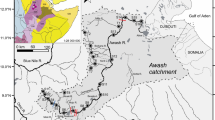Abstract
Biological monitoring of the Fly River system in Papua New Guinea has shown that floodplain habitats (oxbow lakes, blocked valley lakes and seasonally inundated grassed floodplain) support diverse and abundant populations of freshwater fishes. Since monitoring first commenced in the early 1980's, a total of 66 fish species representing 33 families has been sampled, with gillnets and rotenone, from a range of sites located on the floodplains of the Fly and Strickland rivers. The fish fauna was dominated by catfishes in the families Ariidae (11 species) and Plotosidae (7 species), with aquatic invertivores being the dominant feeding group. Herring species (Nematalosa spp.) were often very abundant in the oxbow lakes, forming 66% of the total catch in all the floodplain habitats. The fish communities in the oxbow lakes and blocked valley lakes were distinctly different, with several of the smaller fish species being more abundant in the blocked valley lakes, while the oxbow lakes supported more of the larger predatory species. Catches in the oxbow lakes were also generally higher and more diverse than the blocked valley lakes or grassed floodplain sites. Since the commencement of monitoring, catches from the floodplain sites have varied considerably, both spatially and temporally. Reduced catches seen at some sites are probably associated with natural climatic factors, particularly ‘El Niño’-induced droughts and algal blooms. Introduced species and increased commercial and artisanal fishing may also be affecting stocks of native fish. Fish populations were shown to recover only slowly in lakes affected by severe drought conditions, with extensive mats of floating grasses hindering fish recolonisation. Fish stocks in a lake affected by an algal bloom recovered more quickly than stocks in lakes affected by drought.
Similar content being viewed by others
References cited
Allen, G.R. 1991. Field guide to the freshwater fishes of New Guinea. Publication No. 9 of the Christensen Research Institute, Madang. 268 pp.
Busse, M. 1991. Environment and human ecology in the Lake Murray — Middle Fly area. pp. 441–449. In: D. Lawrence & T. Cansfield-Smith (ed.) Sustainable Development for Traditional Inhabitants of the Torres Strait Region, Proceedings of the Torres Strait Baseline Study Conference, Workshop Series No. 16, Great Barrier Reef Marine Park Authority, Townsville.
Chambers, M.R. 1988. Dissolved oxygen, temperature and zoo-plankton studies of lakes Bosset, Pangua and Daviambu, pp. 19–30. In: U.N.E.P. Regional Seas Reports and Studies No. 99, United Nations Environment Programme.
Coates, D. 1993. Fish ecology and management of the Sepik-Ramu, New Guinea, a large contemporary tropical river basin. Env. Biol. Fish. 38: 345–368.
Halse, S.A., G.B. Pearson, R.P. Jaensch, P. Kulmoi, P. Gregory, W.R. Kay & A. W. Storey. 1995. Waterbird surveys of the Middle Fly River floodplain, Papua New Guinea. Wildlife Research 23: 557–569.
Higgins, R.J. 1990. Off-river storages as sources and sinks for environmental contaminants. Regulated Rivers Research & Management 5: 401–412.
Lowe-McConnell, R.II. 1987. Ecological studies in tropical fish communities. Cambridge University Press, Cambridge. 382 pp.
Munro, I.S.R. 1967. The fishes of New Guinea. Department of Agriculture, Stock & fisheries, Port Moresby. 651 pp.
Roberts T.R. 1978. An ichthyological survey of the Fly River in Papua New Guinea with descriptions of new species. Smith-sonian Contributions to Zoology 281; 1–72.
Smith, R.E.W. & K.A. Bakowa, 1994. Utilisation of floodplain waterbodies by the fishes of the Fly River, Papua New Guinea. Mitt. internal. Verein. Limnol. 24:187–196.
Smith, R.E.W. & K.G. Horde. 1991. Assessment and predictions of the impacts of the Ok Tedi copper mine on fish catches in the Fly River system, Papua New Guinea. Env. Monitoring & Assessment 14: 315–331.
Stauber, J.L. 1995. Toxicity testing using marine and freshwater unicellular algae. Aust. J. Ecotoxicology 1: 15–24.
Swales, S., A.W. Storey & K.A. Bakowa. 1998. Biological monitoring of the effects of the Ok Tedi copper mine on fish populations in the Fly River system, Papua New Guinea. Science of the Total Environment 214: 99–111
Swales. S., A. W. Storey & K.A. Bakowa. 1999. Temporal and spatial variations in fish catches in the fly river system in Papua New Guinea and the possible effects of the Ok Tedi copper mine. Env. Biol fish. (in press).
Welcomme, R.L. 1979, Fisheries ecology of floodplain rivers, Longman, London. 317 pp.
Welcomme, R.L. 1985. River fisheries. FAO Technical Paper 262, Rome 330 pp.
Winemiller, K.O. 1996. Dynamic diversity in fish assemblages of tropical rivers. pp. 99–134. In: M.L. Cody & J.A. Smallwood (ed.) Long-Term Studies of Vertebrate Communities, Academic Press, San Diego.
Author information
Authors and Affiliations
Rights and permissions
About this article
Cite this article
Swales, S., Storey, A.W., Roderick, I.D. et al. Fishes of floodplain habitats of the Fly River system, Papua New Guinea, and changes associated with El Niño droughts and algal blooms. Environmental Biology of Fishes 54, 389–404 (1999). https://doi.org/10.1023/A:1007474501507
Issue Date:
DOI: https://doi.org/10.1023/A:1007474501507




